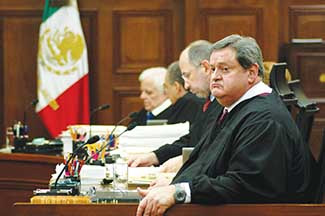
|  |  |  News Around the Republic of Mexico | October 2009 News Around the Republic of Mexico | October 2009  
Process Against Nine Mexican Justices Hindered
 Rocío Zayas - Rumbo de México Rocío Zayas - Rumbo de México
go to original
October 02, 2009


| | (Cuartoscuro/Rodolfo Angulo) |  |
There is a pending process against nine justices of the Supreme Court of Justice of the Nation (SCJN). But the process has not advanced because of their privileged position, said Jorge Humberto Pazos Chávez, lawyer and president of the Association of Management and Judicial Services Professionals.

The justices accused of abusing their positions are Sergio Salvador Aguirre Anguiano, Juventino Víctor Castro y Castro, Juan Díaz Romero, José Vicente Aguinaco Alemán, José de Jesús Gudiño Pelayo, Guillermo Ibero Ortiz Mayagoitia, Olga María Sánchez Cordero Dávila, Juan Silva Meza and Mariano Azuela Güitrón.

In a press conference, Pazos explained that on November 4, 1931, residents of the town San Miguel Tecamachalco, in the State of Mexico, asked for the restitution of 350 acres of land from the Hipódromo de las Américas toward the town. The land was used for the construction of Military Camp Number 1 and an arms plant, not for reforestation as had been planned.

On October 14, 1936, President Lázaro Cárdenas published in the Official Gazette a resolution in favor of the civilians, but it couldn't be carried out because the land had already been built on.

It was later proven that the restitution of 234 hectares was a false act through which the State appropriated the land for its own use.

Pazos said that after more than 70 years, the acts of dispossession by the executive have ended in impunity. The Supreme Court modified at its discretion the intention of the protective writ of execution, whose guidelines were established in the middle of the last century by the Second Court of the institution.

"The process is in the Chamber of Deputies," said Pazos.

"But the president of the Chamber hasn't heard it precisely because it's political. Hearing the proceeding would show evidence of the illegalities and irregularities that these gentlemen have participated in, and still do. These justices have the justice of the country in their hands."

On November 4, 2003, the High Court modified the writ of execution, acting illegally, and signaling that the Supreme Court could interpret the extent of protections already conceded to citizens, and also could modify reports, tests, or any other element that lower courts took into account.

This left the lower magistrates disgraced, because before they had made decisions totally free from pressures from above.
|

 |
|  |



